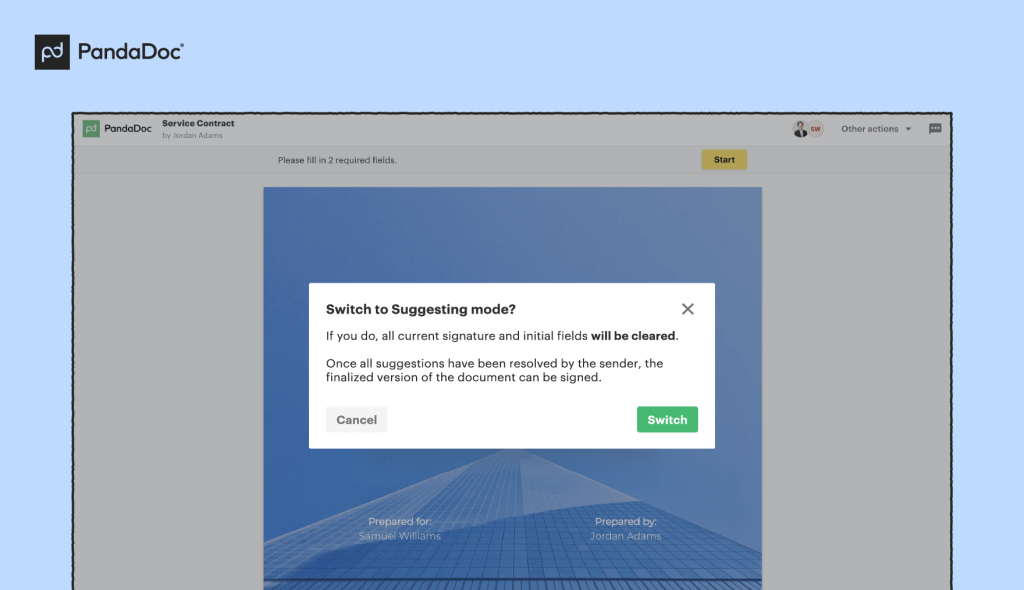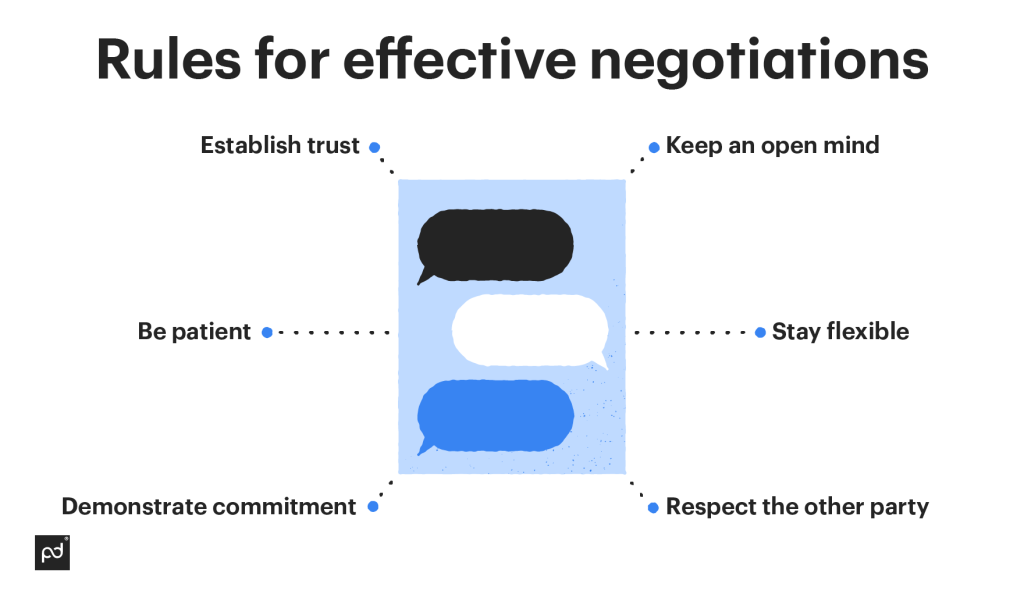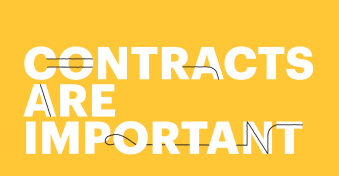If you’ve ever tried to improve your contract negotiations, you’ve probably stumbled across the same set of tips.
Do your research. Know what you want. Come in with a plan. Be prepared to walk away.
While we do consider those tips to be essential to the negotiation process, they don’t actually tell you how to improve your contract negotiations.
In this article, we’ll set you up with 6 tips to help you streamline negotiations for every business contract so that you can nail down essential contract terms and establish new business relationships quickly.
Ready? Let’s go.
1. Track your negotiations
As far as a contract negotiation strategy goes, keeping track of your business negotiations might not seem like a big deal. However, we beg to differ.
When engaging in contract negotiations, it’s important to take notes regarding the details discussed and agreed upon during each meeting or conversation.
Why? Tracking these minutiae helps to ensure that all points of agreement are documented and can be referred back to when needed.
Additionally, recording any decisions made during the contract negotiations allows for better decision-making when it comes time to close the contract and attaining your business goals.
Keeping a record of the discussions helps you better understand where each negotiating party stands on various topics, allowing for smarter decision-making regarding contract terms and conditions.
On top of that, tracking contract negotiations also helps you protect yourself from any potential disputes that may arise in the future due to a lack of clarity regarding certain contractual provisions, especially if the negotiations are conducted over an extended period of time.
PandaDoc makes it easy to do some of this work by providing a full history of document changes and comments inside a single, unified platform.
Keep in mind that you’ll still need to take notes during meetings and record conversations where you see fit outside of your document workspace.
2. Make revisions easy
The revisioning process can make updating and negotiating contracts a painful proposition
Between dealing with counteroffers, liabilities, and multiple stakeholders seeking the best deal, the interval between document revisions and updates can draw out the contract negotiation process.
If you’re looking to hit the bottom line faster and close deals quickly, making revisions as easy as possible is key.
Working in a digital medium makes this easier than ever before.
Platforms that offer collaborative workspaces like Google Docs or PandaDoc help successful negotiations happen in real-time.
Need to update the dispute resolution policy or throw in additional perks in order to reach the best deal?
Digital workspaces allow you to edit that part of the contract in a live environment and get everyone on the same page while the terms are under discussion.

The immediacy of the change can help you increase your bargaining power and broker the best terms for all parties involved since everyone can see the changes as they happen.
3. Version everything
Keeping reliable versions of everything can help when negotiations are breaking down and you need to return to approved language that everyone agrees with.
It can be frustrating to hash out the details of a previously agreed-upon arrangement just because a core component of the contract was deleted or overwritten and not saved.
When you have a set of contract points that everyone feels comfortable with (even if you plan to revisit it later!), take a moment and create a version of the document for review later on.
This is even important on platforms where all changes are saved.
Without the right version, admins and contract negotiators can get hung up looking through multiple iterations of a document to find the right snippet of language.
Even then, if your business partner feels like the text is inaccurate, you might end up back in the process of negotiating the same point a second time.
An agreed-upon version removes all doubt regarding specific contract points.
While nothing is firm on a new contract until the documentation is signed, reviewing old versions can be an effective contract negotiation tactic for getting talks back on track when they’ve stalled.
4. Be specific in offers and deadlines
One of the most famous (and logical) negotiation tips is to go in knowing what you want to get.
While you can expect some give and take as part of the negotiating process, knowing the minimum terms that you’re willing to accept before you begin is a key contract negotiation skill.
At the same time, you don’t just need to know what you want.
You also need to clearly demonstrate to your negotiating partner what that entails.
That’s why it’s critical for you to be specific regarding any offers or deadlines that need to be determined in order for the contract to succeed.
These points should be clearly visible, whether you’re engaged in salary negotiations as part of an employment contract with a prospective employee or you’re negotiating procurement and delivery deadlines as part of a healthcare or manufacturing supply contract.
Fortunately, there are several tools available to help you be exact in this process.
PandaDoc offers pricing tables to create simple and clear estimates around costs and deadlines.
5. Expedite the e-signing process
Time is of the essence when negotiating contract agreements.
The quicker that parties can conclude negotiations and sign off on contract terms, the better it is for everyone involved.
The immediacy of e-signing allows contract negotiations to be finalized as soon as all parties reach consensus.
By expediting this process, negotiators are able to put contracts into action faster, eliminating potential delays that can hinder progress or cause disruption.
E-signatures provide an easy way for all parties involved to quickly authorize documents without having to manually sign papers, accelerating the contract negotiation process with minimal effort and eliminating any risks associated with lost or delayed paperwork.
Plus, quick turnaround and processing times for signed contracts help strengthen relationships between parties by allowing contract terms to be agreed upon and implemented immediately when necessary.
It’s a win-win for everyone involved.
6. Make payments fast and simple
In contract negotiations, simplifying the payment process can have a significant impact on successful contract outcomes.
Nobody wants to wait to be paid, and having a project stall after the paperwork is signed until a wire transfer completes or the bank verifies a charge can throw cold water on a budding business relationship.
Having an efficient and streamlined payment process helps ensure that both parties are aware of when payments are due, how much is owed, and how to move forward with the contract.
This improves transparency in the negotiation process and allows for smoother transitions between different stages of contract implementation.
As an added benefit, expediting payments will also reduce the long-term administrative costs associated with contract management and help to make sure that payments are made on time.
The result: Better contract execution and happier partners who benefit from timely payments and minimal work delays.
Other things to consider when negotiating contracts
Great contract negotiation isn’t just about managing your documents accurately (although doing so can expedite negotiations dramatically).
Here are a few other points you should consider before you dive into any negotiation.
What are the basic steps for negotiating a contract?
Contract negotiations can be complex and require a great deal of attention to detail.
To ensure that you are able to effectively and efficiently negotiate a contract, there are several key steps you should take.
1. Set out your objectives
Prior to the negotiation, define what you want out of the contract and set goals accordingly.
This will enable you to articulate your position more clearly during the negotiating process.
2. Prepare thoroughly
Make sure you are well-informed on the subject matter and have all the necessary facts and figures to hand.
This will help you make a compelling case during negotiations, while also allowing you to respond quickly to any counter arguments put forward.
3. Negotiate terms
Once you have established your objectives and prepared for negotiation, it’s time to begin the process.
It’s important to be open and honest during contract negotiations, as well as ensure that you are aware of the other party’s objectives.
4. Summarize regularly
Regularly summarizing the discussion will help to keep both sides on track and ensure that any progress made is not lost.
This will also make it easier for all parties involved to review the points discussed.
5. Finalize the contract
Once both parties have agreed on all terms and conditions, take steps to finalize the contract.
Before signing, read over the contract one last time before signing it, and send it for a legal review to ensure that the contract is legally sound.
By taking these steps, you can be sure that contract negotiations will proceed smoothly and result in a contract that is beneficial to both parties.
With careful planning and consideration, contract negotiations can be an effective way to reach agreements.
How long should contract negotiations take?
Contract negotiations can be lengthy depending on the complexity of the contract and the parties involved.
Generally, contract negotiations should take anywhere from 2 weeks to 3 months to complete. It is important to allow adequate time for all parties to review and discuss any changes or updates in order to reach an agreement.
Additionally, it is helpful for both sides to keep open communication during the contract negotiation process in order to come to a mutually beneficial agreement.
The contract negotiation period is an important one and should not be rushed or taken lightly.
Taking the necessary time for contract negotiations will ensure all parties are satisfied with the end result.
What are the rules for effective negotiations?
When engaging in contract negotiations, there are several key rules to follow to ensure a successful outcome.

1. Keep an open mind
Be sure to listen carefully to the other party’s points of view and consider any potential compromises that could be made.
Having an open-minded approach may help both parties reach an agreement faster.
2. Establish trust
Try to create a friendly environment in which both sides feel comfortable expressing their views openly and honestly.
It’s important for each side to feel that their interests are being taken into consideration.
3. Respect the other party
Show respect and appreciation for the other side’s position and try to identify common ground between you both.
This will help create mutual understanding and trust in order to reach an agreement.
4. Stay flexible
Negotiations don’t always go according to plan, so be prepared to compromise and make adjustments when necessary.
Remember that both parties should be willing to move away from their ideal outcome in order to reach a satisfactory agreement.
5. Be patient
Negotiations can be long and drawn out, so it’s important to maintain your patience throughout the process.
Don’t rush into making decisions before fully exploring all the options available.
6. Demonstrate commitment
Show that you are committed to making a deal by staying enthusiastic about the negotiation process and offering creative solutions where appropriate.
This will help ensure both parties remain focused on reaching an agreement.
By following these steps, contract negotiations can be conducted more effectively, leading to positive outcomes for everyone involved.
When are contracts negotiable?
Contracts are typically considered to be negotiable when one of the following occurs:
- No contract is currently established.
- A contract is expiring and due to be renewed.
- Business circumstances have changed.
- The original contract is flawed.
Keep in mind that renegotiating existing contracts isn’t always a bad thing and can even be beneficial in some scenarios.
For instance, contract renegotiations may occur when there is a need to adjust contract terms due to changes in market conditions, legal requirements, or other external factors.
In such cases, contract renegotiation provides an opportunity for both parties to reach an agreement that better fits the current business environment.
This can also be used to address any issues or problems that have arisen since the contract was first signed and if either party is unsatisfied with certain aspects of the contract.
What should you do if negotiations are breaking down?
When negotiations have hit an impasse, it’s important to remain calm and take a step back.
Rather than walking away from the negotiating table, consider having an open dialogue with the other party and expressing any concerns or issues that need to be addressed in order to move forward.
Taking the time to listen to each other’s perspectives can help both parties come up with a compromise that works for everyone.
Additionally, it may be helpful to seek out the services of a contract attorney who can provide insight into legal requirements and assist in finding advantageous solutions for all involved parties.
Ultimately, contract negotiations should be approached in a collaborative manner so that an agreement can be reached while preserving the interest of both parties.
This will help to establish trust between the two parties and ensure that contract terms are amicable for both sides.
Better contract negotiations with PandaDoc
Negotiating contracts can be a difficult endeavor, especially if you don’t have the tools needed to expedite the process and keep track of changes.
If that’s the case, PandaDoc can help.
Whether you’re a small business negotiating a new job contract with a potential candidate or a sales pro looking for ways to expect business dealings, the PandaDoc platform comes with all the tools you need to process business documentation even faster.
Take advantage of our document builder and form creator.
Create your own document templates, and use e-signing tools to get your paperwork signed, sealed, and delivered to all parties involved.
Sign up for a free 14-day trial and see how the PandaDoc platform can play a role in your business growth.
Disclaimer
PandaDoc is not a law firm, or a substitute for an attorney or law firm. This page is not intended to and does not provide legal advice. Should you have legal questions on the validity of e-signatures or digital signatures and the enforceability thereof, please consult with an attorney or law firm. Use of PandaDocs services are governed by our Terms of Use and Privacy Policy.


